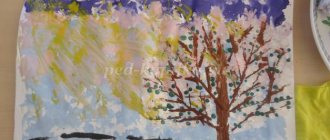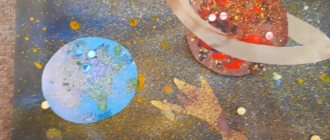Middle group. Junior preschool age. Children 4 - 5 years old
The use of health-saving technologies in the circle work of a speech therapist teacher with children 3–4 years old (from work experience) The problem of preserving, strengthening and shaping the health of the younger generation is the main task of preschool education . The foundation of the well-being of the future generation should be based on protecting the health of the preschool child, on the formation and education of his culture of health...
Circle work on appliqué using non-traditional techniques in the middle group “Fur coat for a sheep”
In the middle group "Barbariki"
A group work was carried out on non-traditional drawing techniques. The goal was to introduce children to the elements of the cotton wool technique: tear small pieces from a large lump, crumple small pieces of cotton wool into lumps and glue them onto the silhouette of a sheep. Develop…
Work plan for a drawing circle in the middle group
Work plan for the “Magic Colors” circle in the middle group
Author: Olga Vasilievna Yakovleva, teacher of the State Budgetary Educational Institution “School No. 842”, Moscow Description of work: I offer you a work plan for the “Magic Colors” circle for children in the middle group (4-5 years old). This material will be useful for educators and additional education teachers working with children of secondary preschool age. This is a work plan for a circle to use non-traditional drawing techniques in visual arts, aimed at developing children’s creative abilities. Goal: Development of creativity in children using non-traditional drawing techniques through group activities. Objectives Learn to use a variety of materials and non-traditional techniques in drawing, different ways of creating an image.
Introduce the genres of fine art and their features. Develop a sense of form, color, rhythm, composition, proportion. To foster interest in fine arts (non-traditional drawing), an aesthetic attitude towards the world around us, and to enrich the child’s emotional sphere. Work plan for the “Magic Paints” circle
September “Amanita” Non-traditional technique:
Finger painting, background – monotype.
Objectives:
Practice finger painting.
Introduce the monotype technique for creating backgrounds. Cultivate neatness. Equipment:
Sheets of paper, gouache, brushes, plastic boards, napkins.
“Rowan Branch” Non-traditional technique:
Finger painting, background – pastel.
Objectives:
Practice finger painting.
Introduce a new material – pastel. Learn to create a background with pastels. Develop a sense of composition and color perception. Cultivate neatness. Equipment:
Sheets of paper, gouache, pastel, stencil of rowan leaves, felt-tip pens or pencils (for painting leaves), napkins.
“Apple compote” Non-traditional technique:
Stamping, drawing with a cotton swab.
Objectives:
Learn to decorate a jar cut out of white cardboard using apple printing.
Learn to use cotton swabs in drawing to depict currant berries. Learn to decorate a craft. Equipment:
Cut out silhouettes of cans from white cardboard, gouache, apples, cotton swabs, brushes.
For decoration: napkins, braid. “Trees in autumn” Non-traditional technique:
Imprint with leaves, imprint with crumpled paper.
Objectives:
Learn to draw trees using leaf prints;
the sky, fallen leaves - the imprint of crumpled paper. Develop a sense of composition and color. Equipment:
Sheets of paper, gouache, brushes, tree leaves, impression paper, napkins.
October “Autumn Forest” (team work) Non-traditional technique:
Drawing using napkins.
Objectives:
Teach children to roll napkin balls and carefully glue them onto the base.
Develop fine motor skills. Equipment:
A sheet of paper tinted yellow (A-3), napkins (red, yellow), cut out silhouettes of trees, glue, brushes, rags, felt-tip pens (for finishing drawings).
“Leaf Fall” (team work) Non-traditional technique:
Pointillism (drawing with dots).
Objectives:
To introduce the technique of pointillism, to learn how to draw in this technique.
Learn to carefully stick leaves for general work. Develop compositional skills. Equipment:
A sheet of paper, tinted blue (A-3), gouache, cotton swabs, cut out silhouettes of leaves, glue, brushes, rags.
“Fruit” (still life) Non-traditional technique:
Drawing using cotton pads.
Objectives:
To introduce the technique of drawing using cotton pads.
Learn to compose a still life. Develop a sense of color and composition. Cultivate neatness. Equipment:
Sheets of paper, gouache, cotton pads, brushes, napkins.
“Cobweb” Non-traditional technique:
Drawing with a colored ball.
Objectives:
Introduce drawing with a ball.
Develop imagination and creativity. Equipment:
Sheets of paper, box lid, gouache, balls.
November “Squirrel in a hollow” Non-traditional technique:
Drawing with palm, fingers.
Objectives:
Learn to draw with your palm, improve your finger drawing technique.
Develop compositional skills. Cultivate neatness. Equipment:
Sheets of paper, gouache, brushes, napkins.
“My favorite toy” Non-traditional technique:
Pointillism.
Objectives:
Improve children's ability to draw with cotton swabs.
Develop a sense of color. Equipment:
Sheets of paper with images of toys, gouache, cotton swabs.
“Magic Umbrellas” Non-traditional technique:
Plasticineography.
Objectives:
To introduce the technique of plasticineography.
Develop a sense of color and fine motor skills. Cultivate neatness. Equipment:
Sheets of colored cardboard, plasticine.
“Kitten” Non-traditional technique:
Poking with a semi-dry hard brush.
Objectives:
Learn to work in this technique.
Learn to depict the appearance of an animal in a drawing. Develop a sense of rhythm and composition. Cultivate neatness. Equipment:
Sheets of paper, hard brush, gouache, napkins.
December “House” Non-traditional technique:
Styrofoam impression.
Objectives:
Improve skills in this technique.
Develop a sense of rhythm, composition, color. Equipment:
Sheets of paper, gouache, brushes, foam stamps.
“Winter Tree” Non-traditional technique:
Drawing with toothpaste.
Objectives:
To introduce new non-traditional drawing materials.
Cultivate neatness. Equipment:
Colored cardboard (black, blue), toothpaste, napkins.
“Herringbone” Non-traditional technique:
Drawing with palms.
Objectives:
Improve your drawing skills in this technique.
Develop compositional skills. Cultivate neatness. Equipment:
Sheets of paper, gouache, brushes, napkins.
“Decorate the Christmas tree with beads” Non-traditional technique:
Drawing with sticks, imprinting with cork.
Objectives:
Practice drawing Christmas tree beads using finger painting and cork printing.
Learn to alternate beads by color. Equipment:
Images of Christmas trees (previous lesson), gouache, corks, napkins.
January “Beautiful snowflakes” Non-traditional technique:
Candle, watercolor.
Objectives:
To introduce this technique.
Develop imagination and creative thinking. Equipment:
Sheets of paper, candle, watercolor, brushes.
“Snowman” Non-traditional technique:
Stamping, drawing with cotton swabs.
Objectives:
Improve skills in this technique.
Equipment:
Sheets of blue paper, carrot stamps, cotton swabs, gouache, brushes.
“Winter” Non-traditional technique:
Drawing on crumpled paper.
Objectives:
To introduce the technique of drawing on crumpled paper.
Develop compositional skills. Equipment:
Sheets of paper, watercolors, brushes.
“Blizzard” Non-traditional technique:
Nitography.
Objectives:
To introduce the technique of thread printing, to learn how to draw using this technique.
Develop imagination and associative thinking. Equipment:
Sheets of paper, gouache, thread.
February “Decorate the mittens” Non-traditional technique:
Poking with a hard brush, painting with cotton swabs.
Objectives:
Improve skills in the technique of poking with a hard brush.
Learn to decorate mittens using cotton swabs. Develop a sense of rhythm and color. Equipment:
Sheets of paper, gouache, hard brushes, cotton swabs.
“Northern Lights” Non-traditional technique:
Monotype.
Objectives:
Improve skills in this technique.
Help in creating an expressive image. Develop a sense of color. Equipment:
Sheets of paper, watercolors, brushes.
“Imagine and complete the drawing” Non-traditional technique:
Creating images.
Objectives:
Teach children to create new images.
Develop creative imagination. Equipment:
Sheets of paper with unfinished drawings, pencils, wax crayons.
“Boat” Non-traditional technique:
Plasticineography
Objectives:
To improve work in this technique.
Cultivate neatness. Equipment:
Colored cardboard, plasticine.
March “Flower for Mom” Non-traditional technique:
Pointillism.
Objectives:
Improve skills in this technique.
Develop a sense of color and composition. Equipment:
Sheets of paper, gouache, cotton swabs.
“Magic Flower” Non-traditional technique:
Drawing with pastels.
Objectives:
Learn to draw flowers with pastels.
Develop imagination and sense of color. Equipment:
Sheets of paper, pastel.
“Clouds” Non-traditional technique:
Drawing on the raw.
Objectives:
To introduce the technique of drawing on raw materials.
Help in creating an expressive image. Develop imagination and observation skills. Cultivate emotional responsiveness. Equipment:
Sheets of paper, watercolors, brushes.
“Spring Sun” Non-traditional technique:
Drawing with palms
Objectives:
Strengthen the ability to draw with palms.
Create a cheerful, joyful mood. Equipment:
Image of the sky, clouds (previous lesson), gouache, brushes.
April “Trees look into a puddle” Non-traditional technique:
Monotype.
Objectives:
Improve children's ability to draw using this technique.
Continue learning how to create an image of a tree. Equipment:
Sheets of paper, gouache, watercolor, brushes.
"Cosmos" Non-traditional technique:
Scratching.
Objectives:
To introduce the grattage technique.
Develop compositional skills. Equipment:
Prepared base (wax crayons, candle, black, blue gouache), wooden sticks.
“Spring Landscape” Non-traditional technique:
Imprint with crumpled paper.
Objectives:
Continue learning how to draw using the crumpled paper imprint technique.
Develop a sense of color and composition. Equipment:
Sheets of paper, gouache, paper for impressions.
“Blooming Branch” Non-traditional technique:
Pipe blowing, applique.
Objectives:
Teach children to draw using this technique, supplement the work with cut out flowers.
Develop imagination and associative thinking. Equipment:
Sheets of paper, gouache, brushes, tubes, cut out flowers, glue, glue brushes, rags.
May “Festive fireworks” Non-traditional technique:
Wax crayons, watercolor.
Objectives:
Learn to depict fireworks using wax crayons and watercolors for the background.
Equipment:
Sheets of paper, wax crayons, watercolors, brushes.
“Beautiful butterflies” Non-traditional technique:
Palm painting.
Objectives:
Improve your palm drawing technique.
Learn to decorate a butterfly using cotton swabs. Develop a sense of color. Equipment:
Sheets of paper, gouache, brushes, cotton swabs.
“Butterfly” Non-traditional technique:
Monotype.
Objectives:
Continue to introduce children to this technique.
Introduce symmetry (based on the butterfly). Develop spatial thinking. Equipment:
Sheets of paper, gouache, brushes.
“Children's Day” (poster) Non-traditional technique:
Drawing with palms.
Objectives:
To consolidate the technique of drawing with palms.
Learn to complement the composition with details using different visual media. Equipment:
Whatman paper, gouache, brushes, napkins, wax crayons, pastels, pencils, felt-tip pens.
Creative works of children
“Amanita”
"Rowan Branch"
"Apple compote"
"Trees in Autumn"
“Autumn Forest” (team work)
“Leaf Fall” (team work)
"Fruit" (still life)
We recommend watching:
Non-traditional drawing technique pointillism Long-term plan for the work of a circle in the senior group Plan of work for a circle for children in the senior group Plan of work for an art club in the preparatory group
Similar articles:
Fine arts lesson for the senior group
Monotype in kindergarten
Non-traditional drawing techniques in preschool educational institutions
Non-traditional drawing technique in kindergarten. Passepartout
Wax painting in kindergarten





